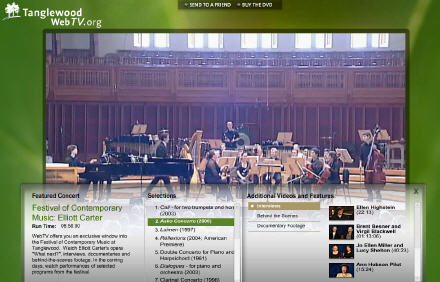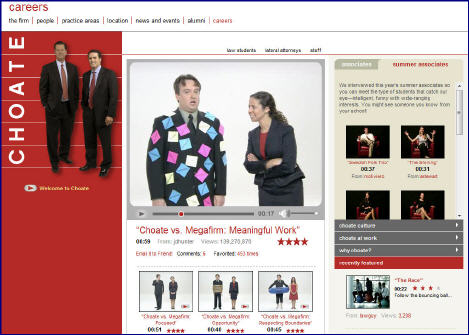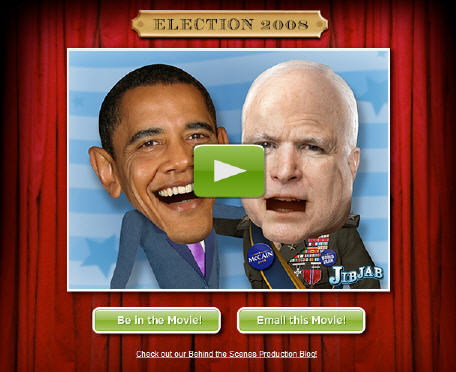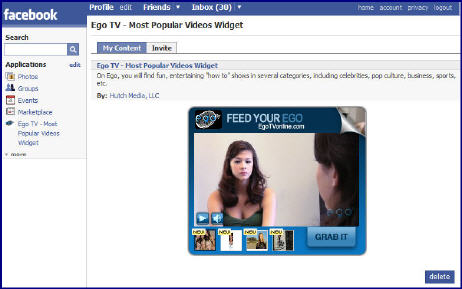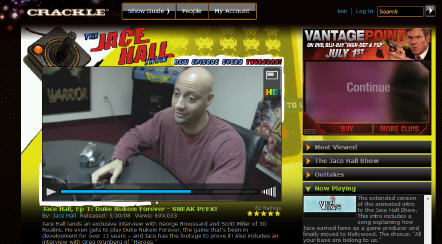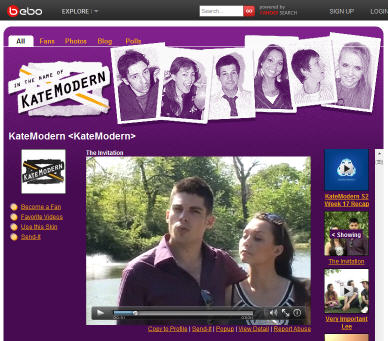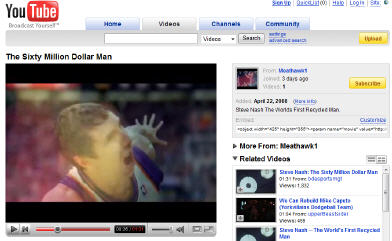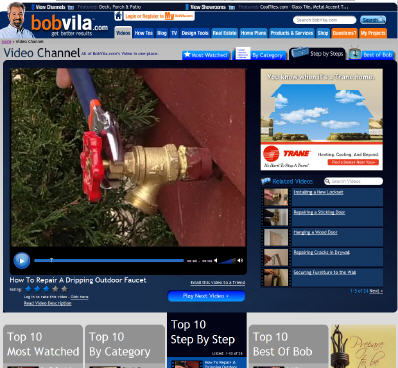-
At Last, Google Flexes YouTube's Strategic Muscles
In the two years since Google acquired YouTube, I've often wondered about two things: (1) was there really a strategic rationale behind the deal? and, (2) if there was indeed a strategic rationale, when might we see it borne out in actual business initiatives?
For sure YouTube's organic growth has continued unabated during these two years and from a traffic
 perspective, it is more dominant now than ever. Yet the dearth of initiatives that are tangibly strategic (or meaningfully revenue-producing for that matter) to Google, or that even minimally strengthen either company's underlying value proposition, has led me to conclude that the deal had more to do with the Google guys wanting to acquire YouTube for its "coolness" factor - simply because they could - than anything else.
perspective, it is more dominant now than ever. Yet the dearth of initiatives that are tangibly strategic (or meaningfully revenue-producing for that matter) to Google, or that even minimally strengthen either company's underlying value proposition, has led me to conclude that the deal had more to do with the Google guys wanting to acquire YouTube for its "coolness" factor - simply because they could - than anything else. I don't mean to sound unfair to the YouTubers who work diligently to make YouTube an incredible experience, which of course it truly is. Yet it is hard to deny the obvious: exactly what has YouTube done differently during the last two years that it couldn't have done had it remained independent (and saying "afforded its monthly CDN bills" doesn't count!), and how exactly have either YouTube or Google benefited from being together during this time?
However, I think things are finally changing. In fact, with little fanfare or proactive PR, Google at last seems to be strategically flexing YouTube's muscles. While some of what they're doing is experimental, other moves have significant market potential and could be highly disruptive to other broadband oriented media and technology companies.
At the top of my "highest potential" list is Google Content Network, especially as it's envisioned as "spokes" tied to YouTube's "hub." I wrote at length about GCN a month ago in "Google Content Network Has Lots of Potential, Implications" so I won't rehash my arguments here. But note yesterday's news about "Poptub" as the second video series to get the GCN/YouTube treatment; I expect a steady drumbeat of these types of deals in the months to come. GCN has the potential to become a key driver of the Syndicated Video Economy.
Another high-potential activity is YouTube's plan to start streaming full episodes. The first deal with CBS is no doubt a signal of many more to come. Full episode streaming is strategic on a number of levels. It enhances YouTube's and Google's access to big brands' ad dollars. While Google has thrived in the self-service, "long tail of advertising" world, it needs more cred among big brands, especially as it pursues its Google TV initiative (see latest deal with NBCU) and other eventual broadband-to-the-TV activities. Full episodes are also a winner from a user standpoint: a unified video experience across premium, indie, long tail and UGC video is very compelling and also squeezes competitors with narrower offerings.
Yet another high-potential activity is the implementation of search ads on YouTube. When the deal was originally done, my first reaction was to think it was a no-brainer to simply start displaying ads against every YouTube search (example - you search for "West Wing" in YouTube and the results page shows an ad to buy the DVD set). If there's one thing Google knows cold, it's the search ad business. YouTube searches represent billions of incremental opportunities each year to extend its core franchise.
 Lastly - and this is admittedly more of a "Will Richmond thing" than anything Google or YouTube are yet pursuing: I think it's practically inevitable that the company will start investing in independent broadband video companies at some point. I touched on this in yesterday's piece about NBCU-60Frames and MSN-Stage 9. As time marches on and some of the above activities bear fruit, it's going to become very tempting for Google/YouTube to lever its strengths more directly into content ownership. I know what Google's always maintained about being a technology company, committed to neutrality in way that even Switzerland would appreciate. But as Google's ad business matures and it inevitably is pressured for growth, content is going to be a very alluring opportunity.
Lastly - and this is admittedly more of a "Will Richmond thing" than anything Google or YouTube are yet pursuing: I think it's practically inevitable that the company will start investing in independent broadband video companies at some point. I touched on this in yesterday's piece about NBCU-60Frames and MSN-Stage 9. As time marches on and some of the above activities bear fruit, it's going to become very tempting for Google/YouTube to lever its strengths more directly into content ownership. I know what Google's always maintained about being a technology company, committed to neutrality in way that even Switzerland would appreciate. But as Google's ad business matures and it inevitably is pressured for growth, content is going to be a very alluring opportunity. Regardless of what happens on this last point, YouTube now seems to have a full plate of strategic activities underway. It's great to finally see this happening.
What do you think? Post a comment now.
Categories: Advertising, Aggregators, Broadcasters, Indie Video, Syndicated Video Economy
Topics: 60Frames, CBS, Disney, Google, Google Content Network, MSN, NBCU, YouTube
-
5 Conclusions About the Bad Economy's Effect on Broadband Video
If you're like me - and millions of other Americans - this past weekend likely found you involved in conversations with family or friends about the dismal state of the U.S. economy and where things go from here.
Of course nobody really knows. I've been spending time trying to get my head around what the economy's implications are for the broadband video industry. I've sought out reactions from industry colleagues, read up on what the "experts" say about a typical down economy's impact and considered my own past experiences. I concede my conclusions are anything but rock solid, but here they are for your consideration:
Broadband access is a now a utility, so addressable video universe remains strong - I was heartened by a new study out last week from Jupiter finding that only 2% of survey respondents would cut off their Internet service to reduce expenses in tough times. That affirms two assumptions I've held since helping launch broadband Internet access service for Continental Cablevision back in the mid-90's: once you're online, you're not going to go offline, and once you're on broadband, you're not going back to dialup. A stable universe of broadband homes means plenty of people to target broadband video to.
Free video beats paid video - With experts suggesting consumer spending is going off a cliff, the free, ad-supported video model becomes even more attractive. Some will counter that advertising spending always contracts in tough times, so relying on ads is no sanctuary. True enough, but my sense is that in this downturn, with the cost of so many essential goods (food, gas, health care, etc.) going up, any ad spending downturn may seem modest compared to the downturn in consumer discretionary spending. Another X factor: if you're paying $45-60/month for broadband Internet access, the more you use it, especially for high-quality experiences, the better value it is.
Advertising on broadband video is less affected than in other media sectors - I heard a widely respected industry analyst say last week that broadband ads will get hammered in this downturn, because most broadband spending is still experimental, and these budgets get eliminated first in a downturn. Yet video ad network executives I've spoken to say that while it's still early days for broadband spending, for many we're beyond experimentation. Plus several other fundamentals suggest broadband ads could hold up decently well: tight inventory for premium video, continued audience shifting to online viewing, better targeting and interactivity, relatively small total broadband spending, etc.
Tough holiday season for broadband devices - I see a tough holiday season coming for all discretionary broadband devices meant to bridge broadband to the TV or enable portable viewing. While they may be cool, for all but the least economically-impacted consumers these devices will fail the "Honey, do we really need this now?" test. That means we're likely to see some shaking out in the broadband device space post-Christmas.
Early stage/indie broadband video providers tighten their belts a bit - While major media companies have existing revenues to support their online initiatives, broadband-only players don't have this luxury. I see early stage/indie providers becoming extra judicious in their spending, likely cutting back on their production plans until the ad climate clears up.
That's all that I have for now. The good news is that broadband video's fundamentals are extremely strong. For all of us in the industry, be thankful you're not in autos, home construction, finance, retail or other hard-hit sectors. Still, there are difficult times ahead for everyone, no question about it. Try to remember the old saying: "what doesn't kill you makes you stronger.'
What do you think? Post a comment now.
Categories: Advertising, Devices, Indie Video
Topics: Jupiter Research
-
Google Content Network Has Lots of Potential, Implications
Many of you know that Google has recently begun distributing short animated videos from Seth MacFarlane (creator of TV's "Family Guy") to a wide network of sites that previously only received ads from Google, through their participation in AdSense. The company dubs this the "Google Content Network" (GCN for short), and from my vantage point, it has a lot of potential and implications for other players in the video distribution value chain. Yesterday, I spoke to Alexandra Levy, Google's Director of Branded Entertainment, and the point person for driving this initiative.
The first thing that resonates for me about GCN is that Google's vision for it harmonizes perfectly with my concept of the "Syndicated Video Economy." VideoNuze readers know that last March I introduced the SVE concept to capture a trend that I was noticing: an ecosystem was forming to distribute broadband video widely across the Internet, in contrast to the traditional, narrower distribution model.
Alex echoed the SVE, saying that in her many conversations with content producers, finding an audience is their top challenge. Great content, unwatched, is like the proverbial tree that falls in the forest when nobody is around to hear it.
So enter GCN, which Google rightly sees as a "media distribution platform." To understand its implications fully, you have to evaluate its potential to all relevant constituencies: Users get great updated content served to them at the sites they already visit. Those sites benefit from offering premium content, while also receiving a revenue share on the accompanying ads. The content provider benefits from leveraging Google's vast AdSense network to have video "pushed" to relevant audiences, increasing viewership and engagement. And advertisers' brands benefit from adjacency to premium content that is sought after and compelling.
Of course, last but not least, Google benefits from being the intermediary in this whole process. We all know from Google's massive success in web search that being the intermediary in a model where all constituent interests are neatly aligned creates near-infinite economic value. While Alex concedes the MacFarlane video (which is sponsored by Burger King and was brokered by Media Rights Capital) is still an "experiment," GCN sure does seem to bear a lot of resemblance to Google's traditional search model in the alignment of constituent interests.
Another twist here is that users who click for more video are driven back to MacFarlane's YouTube channel (already the 69th most subscribed channel, with almost 70K subscribers), which drives habituation, a key lever for ongoing video success as any network TV executive will admit. In this light, GCN gives Google a way of finally tying its powerful AdSense engine to YouTube. I'm not suggesting that Google is sweating the ROI on its $1.6 billion YouTube acquisition, but GCN surely looks like a way to move YouTube far beyond its roots as everyone's favorite UGC aggregator.
Alex is quick to point out that GCN does not budge Google from its often-stated position that it is not a content creator. Rather, it's using GCN to connect brands, content producers and users. If that connecting process drives audiences and generates revenues for content producers - and admittedly the proof is not yet in - that would give Google a lot of disruptive capital to help shape the video landscape. Just so nobody gets carried away, Google announced a similar experiment 2 years ago with MTV that fizzled out. So the company has yet to prove its experiment works and that it is fully committed to the GCN model.
Still, I continue to believe that video syndication - and the accompanying benefits to all - is a key, key driver of how the broadband video landscape is going to unfold. As a small teaser, there will be more interesting news on the syndication front early next week. Stay tuned.
(And note that the syndicated video economy will be one of the main topics of discussion at the Broadband Video Leadership Breakfast "How to Profit from Broadband Video's Disruptive Impact" with our A-list group of panelists, including Google's David Eun, on November 10th. Click here to learn more and register for special early bird rate.)
What do you think? Post a comment now.
Categories: Advertising, Aggregators, Indie Video, Syndicated Video Economy
Topics: Google, Google Content Network, Seth MacFarlane, YouTube
-
Vogue.TV's Model.Live: A Magazine Bets Big on Broadband
I've been writing for a while now that broadband gives non-video media companies a whole new strategic growth opportunity. This is especially true for magazines with well-defined brands, strong advertising relationships and sought-after audiences. Few magazines fit that description as well as Vogue, Conde Nast's high-end fashion bible. So I was pleased to read about a month ago that Vogue intended to launch Model.Live, a 12 episode original broadband-only series, in a partnership with IMG.
Model.Live went live recently, and I've caught the first couple of 8 minute episodes. Shot in a reality/documentary style, Model.Live follows the lives of 3 young and aspiring models. With a budget of $3 million, these productions do not feel like run-of-the-mill low-end indie video. There are multiple camera angles, great lighting, and extensive on-location shoots. Absent are the high-end graphics and faux cliff-hanger moments typically seen on TV contest shows.
While many will find the subject matter and dialogue insipid (19 year-old Dutch model Cato's mildly defiant "I can party when I'm 30..." justification for deferring college is a classic eye-roller); my guess is that for Vogue readers and for those interested in the fashion world, these authentic behind-the-scenes peeks will be quite intriguing. For example, in episode 2 we hear Cato's mother expressing her authentic unease with the modeling world's fame and glamour (of course, her star-struck sister more than offsets these reservations).
The video player allows sharing through email, and easy downloading to iPods. Curiously though, there's no commenting or rating available, two tools now widely used to generate audience interactivity. Also missing is any email or RSS alert function so it's not clear how a fan would know when the next episode will be released. There's not even a teaser for what's coming next, a standard promotional tool for serialized TV shows.
Still, Vogue has definitely nailed certain things. It is smartly distributing Model.Live on the social network Bebo, which is sure to gain the show widespread visibility among targeted younger audiences (it is supposed to be available on Hulu and Veoh as well, though searches at both sites yielded no results). And, for a deal in the reported "low seven figures," it signed up Express to be the program's sponsor. Express gets huge visibility in the right panel of the video player, with clothing purchases a few clicks away. Vogue's ability to drive awareness and revenue for Express will certainly influence whether Model.Live continues on after its first season.
Model.Live actually follows several other programs Vogue has released ("Behind the Lens," "The Collections," Trend Watch") yet, it is clearly the most ambitious. These kinds of shows are a natural extension for the brand, and I believe are essential as Vogue seeks to engage an increasingly online audience seeking out video. Other magazines should be taking note.
What do you think? Post a comment.
Categories: Advertising, Indie Video, Magazines
Topics: Bebo, Conde Nast, Express, IMG, Vogue
-
Tanglewood and BSO Pioneer Broadband Use for Arts/Cultural Organizations
Tanglewood, the summer home of the Boston Symphony Orchestra (BSO), and also the host of world-renowned musical training programs, has expanded its use of broadband video, helping pioneer how arts and cultural organizations can tap into the power of this new medium. I talked recently with Rich Bradway, Associate Director of Ecommerce and New Media to learn more.
First, for those unfamiliar with Tanglewood, it is a lush former estate in Western Massachusetts' Berkshire Mountains containing an outdoor theater and other performance buildings. Open only for the summer, it hosts a mostly classical program, but also features performances by the contemporary Boston Pops and others like James Taylor (whose annual concerts draw over 20,000 fans). For many the Tanglewood experience means elaborate picnics on its expansive lawn, followed by a moonlit night or lazy afternoon of beautiful music.
This summer, the BSO has created TanglewoodWebTV.org, with its first "episode" around the centenary of the birth of Elliott Carter, a well-known composer who's being celebrated in Tanglewood's 2008 Festival of Contemporary Music. Previously the BSO has launched BostonPops.TV, and both are powered by PermissionTV. Rich explained that Tanglewood and the BSO are using broadband to build awareness, reach a younger and more global audience and drive new revenues.
The episode includes performances along with interviews, documentaries and behind-the-scenes footage. The presentation is very non-linear with an overlay menu providing easy navigation to other video segments, so the user can sample at will. Rich said prior to launch the episode was seeded with archival video, and then during the Festival week it was updated continuously. Since broadband is new for the Tanglewood team a key goal was understanding what's involved in the digital media workflow and how to scale the process over time.
With BostonPops.TV and TanglewoodWebTV.org, the BSO is helping prove in broadband's benefits for other arts and cultural organizations. Yet, as Rich and I talked, I mentioned that it seems to me the really big opportunity here is to stream live concerts from Tanglewood, and then make them available on-demand afterwards. This would extend the full Tanglewood experience to remote users in the same way that the Saturday afternoon radio broadcasts of the New York Metropolitan Opera have been doing for decades. Consistent with that model, the streaming should be free and sponsored, rather than paid by the user.
Rich said that the BSO and Tanglewood have been doing the spade work to enable paid concert downloading, focusing on both technology infrastructure and addressing rights issues with the orchestra itself. Rich reminded me that this is all very new territory for a traditional organization. I understand that and the value of a "walk before you run" approach. Still, for arts and cultural organizations like the BSO and Tanglewood, broadband is presenting exciting opportunities to extend their brands and build new revenues; I believe that these should be pursued as aggressively as possible.
What do you think? Post a comment.
Categories: Indie Video
Topics: BSO, Tanglewood
-
Choate Uses Broadband Video to Shake Up Law Firms' Competitive Dynamics
Choate Hall & Stewart is an old-line Boston law firm whose innovative use of broadband video shows how out-of-the box thinking can shake up the competitive dynamics of a very traditional industry.
As Betsy Huntley, Choate's Director of Marketing explained to me, a key audience for Choate (and indeed all major firms) are top law students who are heavily recruited for summer and full-time associate employment. Year in and year out successful recruiting is key to every firm's existence.
Last year, Choate's interactive firm, Greenfield Belser, pointed out that the firm's young recruits were increasingly immersed in the YouTube/Facebook culture, so one way Choate could connect better with them and separate itself from its competitors was by doing something out-of-the box, like offering video.
To put the video idea in perspective, Betsy noted that to their knowledge no other law firm had used video as a recruiting tool (nor has any still). Such an initiative would be groundbreaking, and risky. As a rule, most law firms do not embrace risk or even the appearance of it. Being perceived as ultra responsible custodians of their clients' interests is far more important than looking like a web 2.0 rock star.
Choate's partners debated the video concept intensively, ultimately deciding to go forward. Then, like Hollywood executives, Choate needed to weigh programming ideas, scripts, formats and the like. Scrambling against recruiting deadlines, the impressive results can be seen in the "Careers" section of their web site.
You'll notice first that playing in the center window are several clever spoofs of the classic "Mac vs. PC" ads (complete with reminiscent music), featuring a Choate "associate" and an associate at "Megafirm." In addition, in the right hand navigation are a collection of "Red Chair" interviews where Associates share something about themselves, adding a distinctive personal feel to the site. There are lots of other talking head interviews, humorous skits and vintage footage. Betsy said the guiding philosophy was "though we take our work and clients seriously, we try not to take ourselves too seriously."
The videos have been a huge success for the firm, as Betsy noted they "streamlined every point in the recruiting process" starting with improved candidate self-selection, more productive, in-depth interviews, a higher acceptance rate on offers made and a higher quality of new hires. All recruits said they'd seen the videos and reacted positively. They especially appreciated seeing their friends candidly discussing their experiences.
I give Choate a lot of credit. Embracing video was a risky bet that undoubtedly felt like very foreign territory for the firm. Yet its experience demonstrates how video newcomers can shake up their industries and distinguish themselves from their competition. Further, it also reinforces the notion that video professionals have a huge new pool of clients to work with. As video becomes a core part of more organizations' communications efforts, video experts are going to be in higher and higher demand.
What do you think? Post a comment now!
Categories: Indie Video
Topics: Choate Hall & Stewart, Greenfield Belser
-
New JibJab 2008 Election Video is Live
The JibJab guys just keep cranking out high-quality cartoons in their signature style. The latest, released today at JibJab.com and MySpace focuses on the current presidential election. It's another solid entry, though I must admit the 2004 "This Land is Your Land" spot will always be the gold standard for me. With JibJab's "Sendables" feature, so you can upload your picture and be a part of the video too.Categories: Indie Video
-
Google, Others Syndicating Video Into the Long Tail
The trend toward widespread video syndication to small-to-medium sized web sites continues to gain momentum.
Two recent initiatives - plus others I expect are still to come - point to the increasing likelihood that broadband video's eventual distribution model will look far different from traditional, tightly-controlled approaches. I'm becoming more convinced that "syndicated video economy" concept I sketched out in March is where the market is heading.
The first initiative, covered in a recent NYTimes article, "Google and Creator of 'Family Guy' Strike a Deal" suggests that Google may finally be ready to point its powerful AdSense engine toward video distribution.
 AdSense, as many of you likely know, essentially created a "long tail of advertisers" by dispersing targeted pay-for-performance keyword-based ads to tens of thousands of small-to-medium sized web sites. Including Google Ads has become a no-brainer for many sites seeking to easily pick up a few extra bucks by allocating some on-site real estate to AdSense.
AdSense, as many of you likely know, essentially created a "long tail of advertisers" by dispersing targeted pay-for-performance keyword-based ads to tens of thousands of small-to-medium sized web sites. Including Google Ads has become a no-brainer for many sites seeking to easily pick up a few extra bucks by allocating some on-site real estate to AdSense.Now instead of distributing ads, Google is looking to take the AdSense model a step further by distributing video content (along with ads) to myriad web sites hungry for video, and cash. First up are comedic webisodes from Seth MacFarlane (creator of Fox's "Family Guy"). Google's proposition to small, and even larger sites, makes sense: we'll give you free high-quality video content, all supported by pay-for-performance ads. You get great content and can make money at it. What's not to like? Not much in my opinion. It seems like such a compelling model that one wonders why Google hasn't done this earlier. In fact, they did. Back in August 2006, Google announced a test with MTV to do exactly the same thing (the ensuing YouTube-Viacom litigation no doubt scotched the test). Hopefully this time around Google will have more luck.
Meanwhile, hyper video syndication is not just for the mighty like Google. Consider Jambo Media, a two year-old company with 12 employees which has built out a syndication network now generating over 2 million video views per day. Web sites like BestCelebGossip.com, Epigee.org and MensTech.com may not be household names, but, as Jambo's CEO and co-founder Rob Manoff explained to me, they are representative of virtually unlimited long tail web publishers eager for video, but unable or unwilling to create it themselves.

Rob and his team of ex-affiliate marketing and advertising veterans have created the Jambo Video Network by licensing video from sources such AP, iVillage, Ivanhoe Broadcast News, and then packaging them into "channels" for distribution in a Jambo video player. Of course ads come along with the video content (though Jambo has a separate ad-free "JamboCast" white label solution in the works too).
Affiliate sites can login to their Jambo account to select which channels to receive while customizing the look and feel of the video player. Over 100 sites have affiliated, which Rob believes will grow to several hundred by the end of '08, driving a projected 5 million views/day. Rob said that sites earn $2-4 effective CPM with revenue per day ranging from $10-30 on the low end all the way up to $1,000/day on the high end.
Jambo is pursuing a space that syndicators like Roo, Voxant, ClipSyndicate, Newsmarket and others have been in for a while. All of these players, along with now Google, are doing what Rob articulates well: creating video ad inventory where none previously existed. Such is the power of syndication in the frictionless Internet environment. And why smart content providers - from startups to established TV networks - are recognizing that increasingly, syndication is where the broadband market is heading.
Note: if you want to learn more about syndication and how one big content provider is succeeding with it, please join me for a webinar entitled, "Profiting from the Syndicated Video Economy." The webinar is sponsored by Akamai and will feature a presentation from Greg Clayman, Executive VP, Digital Distribution and Business Development, MTV Networks and me. Registration is free.
Categories: Advertising, Indie Video, Syndicated Video Economy
Topics: ClipSyndicate, Google, Jambo Media, Newsmarket, ROO, Voxant
-
EgoTV, Clearspring Show How Widgets Successfully Distribute Video
"Widgets" are an area that VideoNuze hasn't really touched on to date, yet they are quickly proving to be a potent way of distributing content in general and video in particular. I was pleased to get an email recently from Jimmy Hutcheson, president and founder of EgoTV, a broadband content startup, who wanted to share some details on their success distributing their "Malibu U" program through Clearspring's widget platform. In a subsequent call with Jimmy and Bill Rubacky, who leads Clearspring's marketing, I got a better handle on how the model works.
For those of you not familiar with widgets, they are small chunks of HTML code that essentially create a container into which content can be continuously pushed. Widgets have gained widespread popularity with the rise of web 2.0 social networking sites like Facebook and MySpace, as users can select different widgets for embedding in their personal pages. This allows both the user and visitors to easily view content there. A user can also embed widgets in personal content sites using PageFlakes, iGoogle or others, or can use widgets right on their desktop.
Content providers view widgets as a low-cost opportunity to dynamically distribute content to opted-in audiences. Similarly, advertisers look at widget advertising as an opportunity to reach targeted, engaged audiences.
As an example, EgoTV is now distributing "Malibu U," through Clearspring's widget and its site. Getting the widget is simple, you just click on it, find the social media platform to which you want to embed the widget and go. Jimmy explained that about 50,000-75,000 unique visitors/day can now see his widget. He's able to track video traffic across all places the widget is embedded and when he pushes a new episode, users are automatically notified. I put the widget on my rudimentary Facebook page and this is how it looks:
From an advertising standpoint, you'll notice in the upper right corner a little peel-back flap, which is one of the ways that Clearspring implements advertising. (In fact, VideoEgg's new AdFrames approach unveiled yesterday uses a similar peel-back, which in turn links to Clearspring's widget sharing capability.) Widget ads can work in all kinds of ways, including banners, pre/mid/post-rolls and overlays.
Clearspring's play is to create a "Widget Ad Network" by aggregating the content flowing through its widgets. With 4 billion pieces of content served through its widgets each month and working with many of the top 100 publishers, Bill explained that it is able to offer targeted inventory to media buyers who want to tap into the web 2.0 world.
In short, widget platforms from companies like Clearspring provide both large content providers and smaller ones like EgoTV yet another way of reaching and engaging their fragmented audiences on their terms. I fully expect more content companies, especially early stage ones looking to gain an audience toehold, to take advantage of this low-cost distribution option. Widgets will take their place as yet another distribution choice in the rapidly-evolving "syndicated video economy."
Categories: Indie Video, Technology, Video Sharing
Topics: Clearspring, EgoTV, Facebook
-
Crackle Notches an Early Win with "Jace Hall" Show
The broadband content provider Crackle is notching a win with its new comedy/interview series "The Jace Hall Show." I received a press release that it generated 500K visitors in the first two days following its launch on June 5th and a million to date. I'm always intrigued with what kinds of original broadband programs are working - and why - so I grabbed some time yesterday with Mary Ray, Crackle's VP of Marketing to learn what's behind Jace's success.
For those of you like me who are not gamers, Jason "Jace" Hall is probably unfamiliar. But Mary explained that if you're in the gaming community he's a fairly well-know producer who has a wide network of relationships in the industry. His show brings you into the world of his relationships, making you feel more connected to gamers' movers and shakers. And since he has his finger on the pulse of what the young male gamer audience is looking for, that gives him a real edge. Plus Mary believes that Hollywood still hasn't paid much attention to this market, despite gaming's huge following.
In the program's first episode Jace provided a sneak peek at a Duke Nukem Forever game that has reputedly been in development for 12 years. Gaining this type of access is practically like having exclusive content. Mary said that Crackle didn't do any advance paid marketing for the show; rather the audience was driven purely by word-of-mouth and buzz-building. I joked with Mary - spend no money but gain a big audience - the show sounds like a marketer's dream!
I asked Mary what she thinks the most important takeaway from Jace's early success is. Her feeling was that tapping into what the audience is hungry for is the key. While I agree, I'd go a step further. I think that trying to find talent that already has a following - whether in gaming, TV or some other medium - is a genuine way to improve a program's odds of success. I'm not necessarily talking about A-list talent per se, but rather talent that is at least known within some kind of niche (e.g. finance, comedy, woodworking, etc). That's not say "don't go with unknown talent looking to break out," but I do think it's important to recognize that doing so carries more risk.
The whole area of original broadband content is surging with players like Crackle, Next New Networks, 60Frames, ManiaTV, Break, Heavy, MyDamnChannel, FunnyorDie and lots of others pioneering the model. It's going to be very interesting to learn more about what works and why.
What do you think works in original broadband video? Share your comments now!
Categories: Games, Indie Video
Topics: 60Frames, Break, Crackle, FunnyorDie, Heavy, Jace Hall, ManiaTV, MyDamnChannel, Next New Networks
-
More on Heavy's Spinout of Husky Media
Late last week, news broke that Heavy Media, which operates Heavy.com, one of the leading destination sites for men 18-34 was spinning off its Husky Media unit as a standalone ad management and network company. I found the deal intriguing and followed up with David Carson, co-CEO to learn more and see how it plays into larger trends I've been tracking.
 Broadband ad networks already compete vigorously with each other to build out their publisher networks and cultivate brands and agencies to obtain a share of their spending. The networks are continuously enhancing their technology and trying to optimize their various ad units to demonstrate the superiority of their approach. And as I recently wrote in "Tremor, Adap.tv Introduce New Ad Platforms," some firms are now enabling ad aggregation in an effort to improve their publishers' effective CPMs.
Broadband ad networks already compete vigorously with each other to build out their publisher networks and cultivate brands and agencies to obtain a share of their spending. The networks are continuously enhancing their technology and trying to optimize their various ad units to demonstrate the superiority of their approach. And as I recently wrote in "Tremor, Adap.tv Introduce New Ad Platforms," some firms are now enabling ad aggregation in an effort to improve their publishers' effective CPMs.With this context in mind, a key question is "does the world really need another video ad management and network?" David patiently explained that they've received a lot of outside interest in their units, namely the "barn doors" that are shown before the video plays, the subsequent skin that remains on the sides while the video plays, and the playlist-like queuing of video with ads judiciously interspersed (which Heavy calls its Video Guide). Heavy has avoided pre-rolls entirely. This interest spurred them to separate Husky.
David believes that each of these units offers superior value. As compared with pre-rolls, where David said "bounce" or early termination rates can be 50% (resulting in the actual content never being seen), with Husky's approach, there's a 90% completion rate, and particularly when users come through the Husky "Video Guide", the number of videos consumed can be 3-6 times greater. David also said they're seeing click-throughs averaging 1.6%, above industry norms.
So of course the next question is, if these units perform so well, what's to stop others from introducing them as well? In fact, David would encourage this, as he believes it would help educate the market and maybe help establish these as preferred units. As long as Husky continues to get its fair share that would be a win. Husky has patents on the skin, and how it works with various video players.
David said investor meetings are underway and he anticipates the company completing its own financing. Husky will have its own separate management team. Heavy also announced last week a syndication deal for its Burly Sports show to CBSSports.com, and, no surprise, Husky will be the ad platform. To the extent that Heavy can do other syndication deals where Husky gets included, that will help it gain market share.
Clearly there continues to be a huge amount of experimentation in the broadband video ad market. The Husky deal further shows that sometimes developing technology for your a site's own use can, if successful, end up creating larger financial value.
Categories: Advertising, Deals & Financings, Indie Video
Topics: Adap.TV, CBSSports.com, Heavy.com, Husky, Tremor
-
Cable's Sub Fees Matter, A Lot
In my recent post "Revisiting the Long Tail and Broadband" I explained how broadband is the next step in an evolution of video distribution systems and that now, after many years of growth, cable networks' niche, but collective audiences are exceeding those of the broadcasters.
Several readers emailed suggesting I append an important footnote to this analysis: there is a key business model difference between today's fledgling broadband video providers and cable networks. That difference is that cable networks benefit from monthly "sub fees" or "affiliate fees" that all distributors (cable TV and satellite operators, telcos, etc.) must pay to carry cable's programming. These fees are collected in addition to the advertising these networks sell. No such sub fees are available to broadband video providers (or broadcasters for that matter), at least not yet.
Having been in and around the cable industry for 20 years, I fully appreciate that sub fees matter a lot to cable networks. Since the beginning of the cable industry, they have served as a financial firewall for networks. Sub fees now range from pennies per month to over $3 for ESPN. Even on the low-end a "fully distributed" cable network (reaching approximately 80 million+ U.S. homes) reaps millions of sub fee dollars per month. And remember, that money comes in regardless of how well the network's ratings were that month. (btw, for an explanation of the genesis of sub fees, have a look at "Cable Cowboy," Mark Robichaux's biography of TCI's John Malone).
Cable networks' financial security continues to be translated into improved programming quality. Recently, in "Golden Age for TV? Yes, on Cable," the NY Times' David Carr lamented that broadcast TV seems to be on a degenerative slide to offer "all manner of contests and challenges," yet noted that cable is ascendant with Emmy and Oscar-winning talent dotting its innovative new dramas. No surprise to anyone, financial muscle translates into programming quality.
All this helps to explain why, whenever I moderate a panel including cable network executives, they fall all over themselves to declare their allegiance to their current, paying distributors. Cable networks are stepping gingerly into the broadband era, careful not to upset their enviable business model.
Conversely, broadband upstarts have no incumbent customers to consider. While this frees them to strike creative and wide-ranging distribution deals, as best I can tell, they're going to be totally dependent on advertising for a long time to come. This is why I continue urging that broadband video advertising must mature further, and fast.
While broadband upstarts scramble and broadcasters struggle, cable networks will keep chugging along, nicely fueled by their consistent sub fees.
Categories: Broadcasters, Cable Networks, Cable TV Operators, Indie Video
Topics: ESPN
-
HBO Wakes Up to Broadband
HBO's deal with Apple to include its programs in the iTunes store has received widespread coverage in the last couple of days, particularly because it includes differentiated pricing for the first time.
Indeed, while it's a big story that Apple's Steve Jobs has finally consented to deviate from his "one price for all" approach - which NBC couldn't attain last fall - there is another angle on this announcement: the possibility that, at long last, HBO has woken up to broadband video's potential.
HBO's absence from the broadband scene has been noticeable. As the most profitable and acclaimed TV
 network, I've long thought that HBO had significant upside in pursuing broadband initiatives. Instead it has badly lagged Showtime and Starz, its two principal rivals in the premium network space, as well as other networks.
network, I've long thought that HBO had significant upside in pursuing broadband initiatives. Instead it has badly lagged Showtime and Starz, its two principal rivals in the premium network space, as well as other networks. Showtime in particular has been quite innovative in both creating broadband-only extras for its programs, plus enticing user-involvement opportunities. For its part, Starz has been aggressive in pursuing Vongo, its broadband-subscription service, which continues to make inroads with numerous device partnerships.
Yet HBO has seemed contentedly disinterested in broadband. Between its hefty subscription fees and healthy DVD business, broadband has likely been seen as just a gnat buzzing about. HBO's lack of broadband interest is evident on its web site which has just a smattering of video clips and highlights, and it is fairly static, with little-to-nothing enticing for the broadband user.
In reality, broadband could have likely been adding real value to HBO's business. With the proper incentives, HBO's creative production partners could have easily come up with broadband extras that would have appealed to the diehard fans of its programs. In addition to their sheer programming value, these would have helped drive more fan loyalty and stickiness between seasons. That would help address HBO's churn rate during its off-season periods.
While HBO's iTunes relationship is a step forward, it's a small one. Contrast its approach to soon-to-be-corporate-sibling Bebo's programming model (which I wrote about yesterday), with its intense focus on community engagement and the different philosophies are evident. Of course HBO is a programming powerhouse and there's no arguing with its success. But for it to fully embrace broadband's opportunities, it would benefit from looking at what Bebo and others are currently doing.
Categories: Aggregators, Cable Networks, Indie Video, Video Sharing
Topics: Apple, HBO, iTunes, Showtime, Starz, Vongo
-
Bebo Pursues Distinctive Original Programming Model
Bebo, the social networking giant being acquired by AOL for $850 million, is pioneering a new programming model by mixing original online-only video series, community engagement and brand integration. While in
 LA last week I attended an invite-only session in which Bebo VP of Marketing Ziv Navoth provided an overview of its approach and elaborated on its upcoming plans.
LA last week I attended an invite-only session in which Bebo VP of Marketing Ziv Navoth provided an overview of its approach and elaborated on its upcoming plans.Since its inception in 2005, Bebo has quickly mushroomed to 40 million+ members with a core audience of 16-24 year olds, concentrated in the U.K. While a distant third to Facebook and MySpace in size, the depth of Bebo's user engagement is significant.
I think Bebo has cleverly grasped the notion that by offering original online video series, it is providing valuable, relatively inexpensive fodder for its members to engage with. So valuable is this programming to serving Bebo's larger corporate mission that its "Open Media" model allows content partners to keep 100% of revenue generated.
Bebo's programming initiatives are gaining traction with its members. Its first series, "KateModern," the successor to "LonelyGirl15," the YouTube phenomenon, received 35 million views in its first season, and is currently averaging 1.5 million views per week, according to the company. Its next series, "Sofia's Diary," is getting half a million viewers per episode according to the company, and its broadcast rights were just acquired by FIVER, the UK broadcaster. Other programs launched or in the works include Vuguru's "The All-for-Nots", "Conquering Demons" (in association with Oakley, the sunglass company) and "The Gap Year."
When you look across all these programs, a key thread is that they all showcase young characters to whom Bebo's audience can easily relate and/or fantasize about being. Ziv repeatedly referenced that in Bebo's model, community and programming are inseparable. Bebo encourages members' feedback and involvement in the stories, and in some cases will bend the narrative to members' desires. Meanwhile Bebo offers a range of community tools to help shows gain promotion to its member base. Bebo's promotional capabilities, massive reach and member engagement are of course the main reasons why producers will seek out Bebo as a partner.
If there's one current weakness I perceive in Bebo's programming model it is monetization. Given its young, media-savvy audience, Bebo knows that advertising must be approached with care. To date Bebo has emphasized product placement, but in a way that "propels the story line forward" according to Ziv, and is believable, not gratuitous. This of course necessitates a lot of custom, one-off selling, which not a model that is scalable across dozens of eventual programs. My guess is that traditional pre-rolls and even possibly overlays will have to play a bigger part if AOL wants to fully monetize Bebo's viewership. If done with proper targeting and capping this could be acceptable to its audience.
What I like about Bebo's programming approach is that it is clearly indigenous to the online medium. As such, it is distinct from models like Hulu, which though also valuable, are primarily new conduits for existing broadcast programming. To the extent Bebo succeeds, it will become a model for how new programming that is exclusively tailored for the online medium will work.
What do you think of Bebo's programming model? Post a comment and let everyone know!
Categories: Indie Video, Video Sharing
-
TV's Primetime Emmys Seek Interactive Entries
Further confirmation that the TV landscape is evolving is The Academy of Television Arts & Sciences' (the organization that puts on the primetime Emmys) recent announcement that the Primetime Emmy for Interactive Media will include two new areas of competition that tie user experience to either fiction or non-fiction programming.
This is not a technology award, but rather an award that honors outstanding creative achievement. In
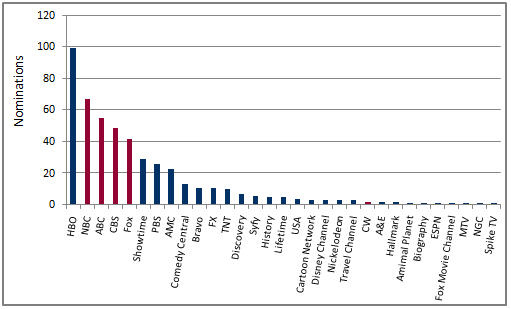 addition to having been distributed by the traditional broadcast, satellite or cable platforms, the recipient of this award could have been born from a variety of new platforms including broadband and mobile, or a combination of platforms.
addition to having been distributed by the traditional broadcast, satellite or cable platforms, the recipient of this award could have been born from a variety of new platforms including broadband and mobile, or a combination of platforms.Why is this newsworthy? Because the door is now open for many broadband video-only programmers, such as Revision3, TikiBarTV, or perhaps LonelyGirl15, who haven't yet inked a deal with a studio, network, or pay TV operator. As long their content fits the interactive criteria, then programs like these could be submitted and become an Emmy contender. A seismic change from yesteryear's Emmy considerations.
To qualify, entries need to be an original program or series that were deployed commercially between June 1, 2007 and May 31, 2008. The Interactive Media Peer group will be judging in June and will select 5 finalists in the aforementioned categories. The Peer Group is looking for submissions that have participatory interactive features and demonstrate overall creative excellence, interactive storytelling, and a compelling user experience.
If you're reading this and you've produced a program or a series that fits this description, the May 30th deadline is fast approaching. And if you don't have content that fits these qualifications, get your game on for 2009. These are exciting times where the democratization of being a Primetime Emmy winner may no longer mean that you're of network ilk. Cool!
Categories: Broadcasters, Events, Indie Video
Topics: Emmys
-
Nike's "Sixty-Million Dollar Man" is Well Worth a Look
A short piece in Brandweek caught my attention yesterday. It was about a new video entitled "The Sixty Million Dollar Man," produced by Phoenix Suns point guard Steve Nash to promote a Nike shoe that Nash has worn since February called the "Trash Talk." The shoe is environmentally-friendly as it is made out of leather scraps and waste. The release of the video coincided with Earth Day.
The video is well-worth checking out, not only because it is a very clever spoof of the original "Six Million Dollar Man" program from 30 years ago and has amazing special effects, but also because it demonstrates the continuing embrace of broadband by brand marketers. This is a trend that I've been covering for a while on VideoNuze (check out here and here for more).
Of course, Nike has long been one of the most innovative advertisers, mixing subtle brand promotion with compelling examples of athletic achievement. The new 90 second Nash spot, available on YouTube, follows Nash's first effort, entitled "Training Day," which itself now has about 300K views on YouTube are in keeping with these traditions. (Apparently Nash is an avid film-maker and also an environmentalist.) In both spots, the only Nike promotion is a swoosh in the closing frame. Both are great examples of sponsored, yet engaging entertainment that would be very expensive to execute on-air.
Broadband is opening all kinds of new doors for brand advertisers. Initiatives seem to fall into 2 buckets: original entertainment/informative videos like the Nash spots, and user-generated contests like the recent TideToGo and Heinz Top This efforts. I expect we'll see a lot more broadband experimentation from brands to come.
Categories: Brand Marketing, Indie Video, Sports
-
Insights Aplenty from How-to Video Category
One of the hottest corners of the broadband video market is the ad-supported "how-to" category. How-to lends itself well to video because, if a picture's worth a thousand words, a video is surely worth a million. Recognizing this, there's now a host of start-ups in this category which together have raised tens of millions of dollars. I wrote about some of this a couple months ago.
Several recent calls with industry participants got me to thinking the how-to category actually offers many valuable insights for all broadband industry participants. These fall into 3 key areas: content development, traffic acquisition and monetization.
1. Content: "Build Our Own" or "Offer a Superstore of Others' Videos"?
Players like Expert Village, 5Min, VideoJug and MonkeySee are pursuing the "build our own" video library approach, incenting individual "experts" to contribute to their sites. On the other hand, sites like WonderHowTo (WHT) and SuTree rely primarily on scouring user-generated video sites like YouTube, plus those above to aggregate the best videos available. With how-to being the ultimate "Long Tail" space,
 WHT's Stephen Chao told me in a recent briefing that trying to cover the infinite number of niches would be impossible. So to be comprehensive, relevant and high-quality, WHT curates what its crawlers return with a small in-house team and presents the cream of the crop to users, complete with a range of community-building features.
WHT's Stephen Chao told me in a recent briefing that trying to cover the infinite number of niches would be impossible. So to be comprehensive, relevant and high-quality, WHT curates what its crawlers return with a small in-house team and presents the cream of the crop to users, complete with a range of community-building features. Here's one non-statistically significant example that illustrates the two approach's results: I did a search for "bbq steak video" on Expert Village, which bills itself as the "World's Largest How-to Video Site" and on WHT. EV returned 15 results, regrettably not one of which was relevant. WHT returned 357 results, and on the first page of 20 results alone, at least 12 looked relevant. These came from a wide variety of sources. Try doing a few searches and see what you find - my guess is your experience will be consistent with mine.
2. Traffic acquistion: Syndication or SEO?
All of these sites are ad-supported, so traffic is key. The sites with private libraries can syndicate to heavily-trafficked partners. Ordinarily, as a big syndication fan, I'd say that sounds like an advantageous traffic generating plan. But how-to may have a different traffic acquisition dynamic. It may well be that far more traffic will always come to these how-to video sites via searches at Google and other search sites, as compared with the sum of various syndication deals. That's because, absent a household brand-name in how-to, default consumer behavior may well be to simply type their how-to video query into Google.
If that's the case, then it will actually be those sites which have the most highly-optimized pages for all the
 niche videos that will gain greater traffic. Though I'm not an SEO expert, it seems to me that, taking my "bbq steak videos" example, WHT, with 357 related videos can optimize better than say EV with 15. And sure enough, when I ran the "bbq steak video" search on Google, right on the first page is a result from WHT, whereas nothing shows up for EV even after 5 pages. Bottom line: more relevant videos = more zero cost, Google-driven traffic.
niche videos that will gain greater traffic. Though I'm not an SEO expert, it seems to me that, taking my "bbq steak videos" example, WHT, with 357 related videos can optimize better than say EV with 15. And sure enough, when I ran the "bbq steak video" search on Google, right on the first page is a result from WHT, whereas nothing shows up for EV even after 5 pages. Bottom line: more relevant videos = more zero cost, Google-driven traffic. 3. Monetization: Video ads or Keyword-driven text/display ads?
Last but not least is monetization. How-to sites have lots of contextual ad potential. In my "bbq steak" example, any company that sells grills, steaks, sauces, etc, would love to advertise to me. It's tempting to believe that those with their own video libraries have more profit potential, because they can sell pre-roll or overlay ads, whereas a superstore site like WHT or SuTree cannot, because they're linking off to the source sites.
But consider this: how many of these potential advertisers will actually have video ads or the budget to create them? Unlike entertainment video, how-to, with its Long Tail character, seems to lend itself more to a low cost keyword ad approach which can be pursued by even the smallest advertiser. So say WHT or SuTree can build traffic in all those video niches and surround the video with keyword-driven text or display ads, all automated through a bidding system. Though yielding lower revenue per ad, my bet is that the total revenue for all ads with the keyword approach would be greater.
Summary
The how-to category is nascent and dynamic. I'm not suggesting for a second that it's a winner-take-all space or that all of the above are strictly "either/or." But I do believe the above analysis raises valuable points all industry participants should consider when developing their content, traffic and monetization strategies.
What do you think? Post a comment now!
Categories: Advertising, Indie Video, Startups, Strategy, Video Search
Topics: 5Min, Expert Village, MonkeySee, SuTree, VideoJug, WonderHowTo, YouTube
-
BobVila.com Illustrates Opportunities, Challenges for 'Mid-Tail' Content Providers
I frequently hear the same segmentation framework used to describe today's broadband video providers. Between the small group of premium providers (e.g. broadcasters) and user-generated sites (e.g. YouTube), lie the so-called "mid-tail" (in "Long Tail" terminology) providers such as newspapers, magazines, online publishers, and indie producers. BobVila.com is a perfect example of a mid-tail provider. Dan Newberry, the company's VP Advertising and Marketing, who I recently spoke with, discussed these opportunities and challenges.
Some of you may know that Bob Vila hosted a hugely popular PBS program from 1979-1989 called "This Old House." He then set up his own production company and produced 2 syndicated shows, "Bob Vila's Home Again" and "Bob Vila." At the end of the latter's run, he decided to shift his focus exclusively to online, to his BobVila.com web site which had been growing since the Internet's earliest days.
As Dan explains, one of the motivations (in addition to Bob Vila's personal reasons) was the improving climate for online advertising in general and video advertising in particular. The economics of creating quality programming for TV vs. for online, plus the CPMs available online, made the case for shifting to online only. The site now generates 1.7 million unique visitors/mo and 600K-700K video streams/mo, with 1,700 video clips available.
Responding to its audience's desires, BobVila.com now produces 5-7 minute step-by-step how-to videos for the site. It has created about 100 since June '07. While broadband enables this new model, Dan is clear about the challenges.
First and foremost is making the financial equation work. This involves producing videos on a disciplined budget and maximizing ROI. Their target cost to produce each video is $4-5K, which requires a different approach than with TV production. Given current viewership and CPMs, Dan calculates that break-even on an individual video is projected at 24 months.
To monetize their video, BobVila.com uses an internal sales team and is able to generate pre-and mid-roll CPMs in the $25-40 range. If there's unsold inventory then it uses a network to sell it, usually garnering $7-12 CPM. In addition, it also selectively uses overlay ads from Google AdSense. Setting the ad strategy to maximize revenue is key. As Dan noted, staffing and managing an internal sales team in this highly competitive environment is a challenge that startup sites need to fully recognize.
Increasing video views is another key challenge. Acknowledging the limitations of search and on-site generated traffic, BobVila.com is ramping up an aggressive syndication effort. While offering lots of upside, Dan explains that this syndication will present new operational and financial complexities such as ensuring BobVila.com gets paid, content is distributed where and when it should be, enforcing various rights issues, etc. Dan pointed out the importance of having a solid technology partner (BobVila.com used PermissionTV) which enables syndication, flexible players and content management.
When you put it all together, it's clear that while broadband offers mid-tail providers like BobVila.com huge new opportunities, it also creates new challenges and responsibilities that many content providers have not typically dealt with. Surmounting these will determine how well these mid-tail providers ultimately fare.
Categories: Advertising, Indie Video
Topics: BobVila.com
-
60Frames Pioneers "Broadband Studio" Model
Last week I had a chance to sit down with Brent Weinstein, CEO/founder of 60Frames, which is among a new group of companies I refer to as "broadband studios." This is a category that has generated a healthy amount of funding and activity recently, including, among others, Next New Networks ($23 million to date), Generate ($6 million), Revision3 ($9 million), Stage 9 (Disney/ABC's in-house unit), Vuguru (Michael Eisner's shop) and a slew of comedy-focused initiatives. 60Frames itself has raised $3.5 million from Tudor, Pilot Group and others.
The impetus for 60Frames came when Brent was heading up digital entertainment at UTA and observed that many clients wanted to create digital/broadband fare but wanted a partner for the same roles they've come to
 expect studios to handle (e.g. financing, distribution, legal, creative, etc.). 60Frames aims to differentiate itself from the pack by being "artist-friendly" - allowing greater creative control and more significant ownership and by relying on strong relationships. With an existing staff of 11 and a goal of launching 50 programs by year end, the 60Frames team is no doubt going full tilt.
expect studios to handle (e.g. financing, distribution, legal, creative, etc.). 60Frames aims to differentiate itself from the pack by being "artist-friendly" - allowing greater creative control and more significant ownership and by relying on strong relationships. With an existing staff of 11 and a goal of launching 50 programs by year end, the 60Frames team is no doubt going full tilt.60Frames is following a traditional portfolio approach, working with great talent (Coen brothers, John August, Tom Fontana, others) but recognizing that results in this new medium will vary - there will be some winners and some losers. The goal is obviously to have the best ratio possible. Traditional studios improve their odds by using collective history and data about what types of projects succeed and which ones don't. But no such lengthy track record or data exists in broadband just yet, so it's a lot more speculative pursuit.
I asked Brent if there's any creative formula 60Frames is using to guide its decision-making. He was pretty emphatic that there's no "formula," but did concede 60Frames is focused on short-form (under 5 minutes), is biased toward comedy where episodes can stand alone more readily, and is mainly looking at niche audiences with a bulls-eye of 18-34 men, where consumption is highest.
Nurturing relationships and developing great content is only part of the equation for these budding studios' success. Distribution and monetization are also incredibly important, as broadband necessitates an entirely different model. Regarding distribution, I was encouraged to see 60Frames is solidly in the syndication camp to the point that it has not even set up destination sites for its 7 launched programs yet. 60Frames has a network of partners including Bebo, blip.tv, DailyMotion, iTunes, MySpace, YouTube and others. Gaining access to all the popular online destinations will accelerate success. Meanwhile advertising is being handled by partner SpotRunner, which has deep hooks in the space.
Broadband studios like 60Frames harken back to the original studio moguls in some ways - taking creative and financial risk to explore what works in a new medium. It's way too early to know if or to what extent they'll succeed, but if they do we can expect a gold rush of imitators.
Categories: Indie Video, Startups, Syndicated Video Economy
Topics: 60Frames, ABC, Bebo, blip.TV, DailyMotion, Disney, Generate, iTunes, MySpa, Next New Networks, Revision3, Stage 9, UTA, Vuguru
-
Heavy Plans Big Push for Husky Ad Platform
(Note: This is the second in a series of posts with companies participating in the 2008 Media Summit, a premier industry event which will be held next week in NYC. VideoNuze has partnered with Digital Hollywood, the Media Summit's organizer, to provide select analysis and news coverage.)
Heavy Corporation, which operates Heavy.com, one of the most popular independent broadband video destinations for 18-34 males, is poised to make a push into the ad platform/network business through its
 Husky Media unit. I spoke to Eric Hadley, Heavy's chief marketing officer yesterday who filled me in on their plans.
Husky Media unit. I spoke to Eric Hadley, Heavy's chief marketing officer yesterday who filled me in on their plans.The Husky platform is currently used today by Heavy.com. If you go to the site, you'll see how it operates, showing just one ad with the video selected. As Eric explains, the video is wrapped in the advertiser's skin, so upon starting the video player exposes a big interstitial ad for 2 1/2 second that sort of feels like "barn doors" before opening to the video itself. Then when the video plays, display ads surround the content. Additional related content is queued up and automatically starts playing subsequently. This approach has resulted in a 270% lift in videos viewed as compared with the pre-queuing implementation. This of course means more video usage and more advertising exposure.
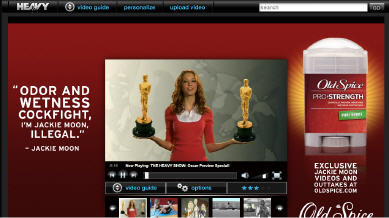 Eric believes that this video presentation/ad format is unique in the industry (I agree, I haven't seen anything else like it), and goes straight to the biggest question in the industry: how are people actually going to make money from their broadband video content, especially original creations. Husky aims to combine the best of pre/mid-roll ads with the best of display.
Eric believes that this video presentation/ad format is unique in the industry (I agree, I haven't seen anything else like it), and goes straight to the biggest question in the industry: how are people actually going to make money from their broadband video content, especially original creations. Husky aims to combine the best of pre/mid-roll ads with the best of display.Eric said that advertiser enthusiasm for the Husky presentation has prompted Heavy to now offer it to other publishers who target demos other than Heavy.com's 18-34 males. It's still early days, but Eric said that in the next few weeks several major publishers will be launching Husky implementations, as will small-to-medium sized sites. This will form the beginnings of an ad network Heavy can assemble and offer to advertisers. By evolving Husky's focus from internal-only use to external use as well, Heavy will be competing with broadband ad players such as Tremor, Broadband Enterprises and others. The Husky move shows how dynamic the broadband video ad space is, with multiple kinds of formats and implementations being tested and used by content providers seeking to maximize monetization.
Meanwhile Heavy is continuing to build out its Heavy.com destination site, which currently receives 17M+ visitors/mo. Key upcoming focuses are music/urban, cars and racing, sports and travel categories. These are all the purview of the Heavy's recently added head of programming, Jimmy Jellinek, former editor at Maxim. Content sourcing is varied, with Heavy.com producing some of its own, producing some for its advertisers and also some it obtaining some from others, such as Transworld. In the U.S. today, Heavy does not syndicate its programming to others sites, which is a somewhat contrarian position vs. other content providers who are syndicating widely.
Looking ahead to the Media Summit, Eric plans to explain more about the upcoming Husky push and how content providers and advertisers can benefit from it. He also sees the Media Summit as an ideal forum to learn from others what's making a difference in the industry and what's hot.
Categories: Advertising, Indie Video, Technology
Topics: Heavy, Husky Media


